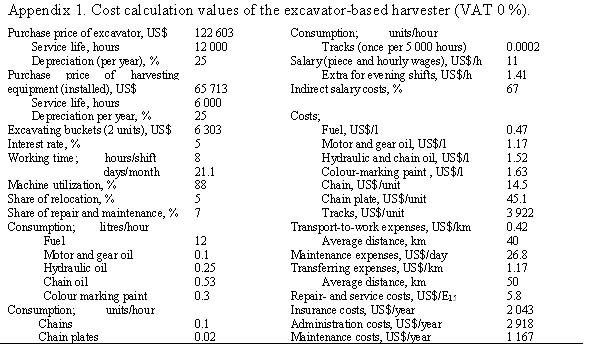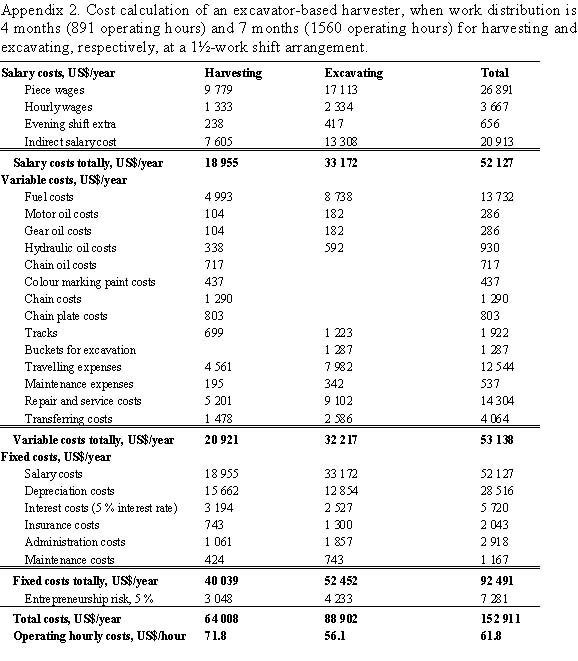
Vol. 15 No. 2, March 2004
Kari Väätäinen
Lauri Sikanen
Antti Asikainen
Finnish Forest Research Institute
Joensuu, Finland
The authors are, respectively, Researcher, Senior Researcher and Professor at the Joensuu Research Center of the Finnish Forest Research Institute
ABSTRACT
In the next twenty years in Finland, annual cuttings on peatland forests are foreseen to increase by up to 30 % of the total cuttings. Cost effective harvesting methods on low yield peatland forests coupled with low ground bearing capacity are required. One solution to improve the feasibility of harvesting could be excavators tailored for forestry use and equipped with a harvesting head.
In the study, cost competitiveness and productivity of the excavator-based harvester were investigated. The cost analysis focused on operating hours of harvester use, shift arrangements and purchase prices for the base machine and harvesting equipment when the base machine was used partly as a harvester and an excavator. Results were compared to conventional wheeled harvesters.
If the base machine is used more than 3 working months as a harvester in addition to normal (6-8 months) excavator work, the harvesting method would be cost competitive compared to purpose-built harvesters (if 1½ and 2 shift arrangements were used). The 25 % increase of the base machine's and harvester equipments' purchasing costs did not eliminate the cost competitiveness of harvesting, when harvesting was carried out in 1 ½ shifts for at least 4 months.
It would be feasible and profitable to invest in harvesting equipment for the excavator and therefore diminish the winter lay-days of the base machine by utilizing it in logging operations. Conditions on peatland sites mean that during the winter time the use of the excavator-based harvester is ideal, when the utilisation of all logging machines is at its highest.
Keywords: excavator-based harvester, single-grip harvester, peatland, thinning, CTL -method, cost analysis, operating hourly cost, Finland.
INTRODUCTION
In Finland, ditched peatland forests represent 24 % of the total forestland and in some provinces their share amounts to 40 % or more of the productive forest area [1]. During the 1960s and 1970s in particular, there was a significant effort to increase production of round wood on peatlands, due to an increased demand for timber and pulpwood by the forest industries [11]. The expected intensive utilization of peatland forests has not taken place mainly due to the associated expensive harvesting and logistic costs and the availability of more attractive alternative wood supply lines. Today, most of the peatland forests are at a young stage and in need of first thinnings and reditching [10].
In recent years, the amount of annual cuttings has been less than 10 million m³ in peatland forests in Finland, but scenarios based on the National Forest Inventory data suggest that annual cuttings can increase up to 15-20 million m³ within the next two decades [12]. This figure corresponds to about 30 % of total annual cuttings in Finnish forests. In order to meet the yield expectations, there is an apparent need for the large-scale application of first thinnings and other forestry operations on peatland forests.
The low harvesting yield and small size of the trees, pose a large challenge on mineral and peat soils. In addition, there are factors that weaken the economics of logging on peatlands. Loggings are mainly carried out during the wintertime on frosted and snowy peatlands due to the low bearing capacity of the ground and the location of tree roots close to the soft soil surface during the unfrozen period. Timber hauling faces difficulties with the ditch network, which determines the main moving direction and the locations of the thinning tracks resulting in longer hauling distances. In addition, tree distribution is uneven, since most of the merchantable trees are located close to the ditches. Therefore it is necessary to employ cost-effective harvesting equipment to accomplish the expected work effort on peatland forests.
Excavators are commonly used world-wide for earth moving on various construction sites. Base machines are mass produced on assembly lines using standard components. When compared to conventional harvesters, the excavators' lower investment costs have been a major reason to use them as base machines equipped with a harvester head. Excavators have been used as a base machine to carry out various logging operations for a long time in, e.g. Canada, USA and New Zealand [5]. In recent years the popularity of excavators as harvesters has increased in Great Britain [4] and Ireland [8] where CTL method has been the main logging method. Correspondingly, in Finland, it is estimated that approximately 10 to 15 excavator-based harvesters will be employed in logging operations during the forthcoming winter season (2003-2004) [7].
New innovations and solutions have been created for excavators to improve the working ability of forestry operations. Excavator manufacturers have improved the ergonomic aspects of the machine resulting in better ergonomic conditions close to conventional harvesters [5]. Nevertheless, difficulties in regards to cabin access and ergonomics are assessed as "less good" [5]. Excavators equipped for forestry operations have an undercarriage with high ground clearance, which improves the mobility in stands with large obstacles (stumps, stones etc.) [9]. These undercarriages can be equipped with wider tracks to further diminish their impact on the ground.
From the point of view of thinning operations some excavator manufacturers offer a concept of maincarriage having no tail swing extension. Tail swing has been the primary reason for not utilizing the excavator-based machines in thinnings [5]. The implementation of an additional boom, with integrated aiding device, at the end of the main boom provides greater reach of the harvester head and a possibility to help the motion with the boom, when conditions impede the movement of the base machine [10].
In Finland, excavators have been used mainly in ditching operations, but also in soil preparation work, forest road construction and tree planting. For various forestry operations, excavators have been used also in other countries such as Ireland [3, 8] and Sweden [17]. Wintertime ditching is restricted in Finland by regulations and so a large number of excavators are idle. Instead of winter lay-days there is a possibility to use the excavator as a base machine for a harvester and thereby provide a feasible solution for wintertime-stressed loggings on peatlands.
The aim of this study is to illustrate the feasibility of utilising the excavator as a harvester on its lay days, with it continuing its basic excavator work the rest of the time. The cost-competitiveness of an excavator-based harvester was compared to thinning harvesters and midsize harvesters. Additionally, a trend setting unit cost calculation was formulated from one operator's productivity values in thinnings with excavator-based harvester [10] and was compared to the thinning harvesters.
MATERIALS AND METHODS
Cost-calculations were based on the methods used by Salo and Uusitalo [14], where the costs of the forest machines were calculated based on the wood harvesting cost calculation model. Total machine costs included capital costs, operator's salary cost, operating and maintenance costs and overhead costs. In addition to the total cost, 5 % was added to take into account entrepreneurship risk. The values of cost elements used 2001 as a base level. Costs were calculated without value added tax (VAT 0 %) and an interest-rate of 5 % was applied. In the cost calculations the currency conversion rate 1 € = 1.1672 US$ was used.
Cost comparisons were made for harvesters specially designed for thinnings and conventional midsize harvesters. The cost values of thinning specific harvesters, which are also capable of harvesting standard sized clear-cuttings, were referred from the publication of Ryynänen & Rönkkö [13], where the productivity and costs of different wheeled thinning harvesters were studied. An entrepreneurship risk of 5 % was added to the referred costs of thinning harvesters in order to make the costs of the machines more comparable. In the cost calculations, the values of the harvesting cost factors were calibrated to the same level for as the excavator-based harvester and the midsize harvester (Appendix 1). An exception was repair and service costs, which were 5.8 US$/operating hour for the excavator-based harvester and 8.2 US$/operating hour for the midsize harvester. Table 1 highlights some of the basic values of the studied machines.
The purchase prices of the excavator and its harvester equipment were attained from the Kobelco excavators dealer (Kesko Ltd. Konekesko) in Finland. The excavator used in the cost calculations was the Kobelco SK135SRL equipped for forestry use with the Foresteri 22 harvester head and the Epec 50 measurement system. Additionally, in this case, harvesting equipment includes an extra boom, cabin safety glasses, extra lights (and charger) and hydraulic pipe installations. Some technical data about the excavator is presented in Table 2.
Both excavating costs and harvesting costs, were included in the cost calculation model of the excavator-based harvester. Costs of excavating and harvesting were separated to ensure that all costs were divided into different work types by their actual work time. Work type specific equipment capital costs and its operating costs were applied only to the appropriate work element. E.g. harvester equipment costs applied only to the harvesting element. An example of the cost division to different work and hourly cost calculation is expressed in Appendix 2. With the installations, the harvesting equipment's total purchase cost was 65 713 US$ (VAT 0 %). Additionally for the excavator, costs included two different ditching buckets totalling 6 303 US$ (VAT 0 %). For the calculations machine utilization was 88 %. In addition relocation comprised 5% of the time, with the remaining 7% being repair and maintenance.
Table 1. Basic values of the studied machines and the cost calculation.
| Excavator-based harvester | Thinning harvester | Midsize harvester |
|
| Purchase price, US$ (VAT 0 %) (+ harvesting equipment, VAT 0 %) | 122 603 (65 713) | 260 904 | 385 916 |
| Service life, hours (SL of harvester head) | 12 000 (6 000) | 12 000 | 15 000 |
| Operating hours annually, h | 2450 (in 1½ shifts and 11 work months) | 2570 | 2600 |
| Machine utilization, % | 88 | Not mentioned | 88 |
| Interest rate, % | 5 | 5 | 5 |
| Entrepreneurship risk, % | 5 | 5 | 5 |
| Weight level of machine, tonnes | 14-16 | 11-12 | 13-16 |
Table 2. Technical data of the Kobelco SK135SRL and the Kobelco SK135SRLC excavators.
| Characteristics | Kobelco SK135SRL | Kobelco SK135SRLC |
| Weight, tonnes | 16.2 | 14 |
| Engine power, kW | 70.1 | 62.5 |
| Ground clearance, mm | 600 | 455 |
| Pulling force, kN | 157 | 127 |
| Overall width, mm (with 900 mm width tracks) | 2 940 | 2 940 |
| Tail swing, mm | 5 | 5 |
For formulating a trend-setting estimation of the unit costs of harvesting with an excavator-based harvester, productivity levels of the excavator-based harvester were taken from the publication of Niemi et al. [10], where an excavator-based harvester (Kobelco SK135SRLC) was employed in peatland thinnings during the winter of 2001 (Figure 1). A harvesting cost comparison was made among purpose built thinning harvesters and an excavator-based harvester (Table 2).
Figure 1. Productivity per operating hour (E15) of 14 tonne's excavator-based harvester in a wintertime (3 months) peatland thinnings [10].

RESULTS
Results of the excavator-based harvester's operating costs were expressed using different work shift arrangements, when the share of harvesting and excavating works differs in months (Figure 2). Same shift arrangements were used for excavating and harvesting. The maximum working time for the excavator was set at eight months per annum. The operating hourly costs of the purpose built thinning and midsize harvesters were 74.1 US$ and 78.4 US$, respectively, when the annual work time was 11 months.
Figure 2. The effects of work shift arrangement and harvesting month changes to operating costs per hour of the excavator-based harvester.
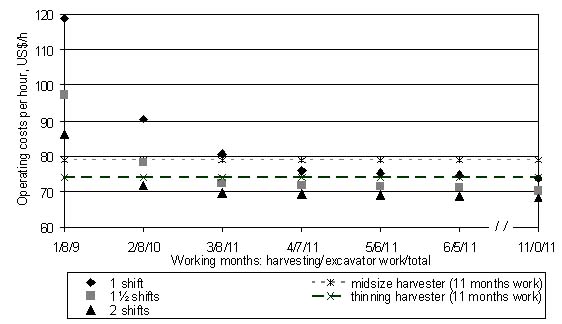
There is a significant decrease in the operating hourly costs of harvesting. This varies from one to three months depending on the work shift arrangements. The excavator-based harvester's hourly costs undercuts the thinning harvesters' hourly costs, when excavator-based machine is used for harvesting for at least three months in either 1½- or 2-shifts. A single shift's operating hourly cost is 8.1 US$ higher than operating as 1½ - shift arrangement, when harvesting was done for 3 months. If harvester work is carried out over a period of 11 months annually with a 1 work shift arrangement, operating costs per hour are the same as the thinning harvester with 1½-work shifts. Additionally, the basic excavator's operating cost per hour decreases 3.2 US$, when base machine's annual work time increases from 8 to 11 months.
The effects of the excavator's purchase price change regarding the operating costs of harvesting are presented in Figure 3, when the base price of the excavator (122 603 US$) varied ± 25 % and 1½-work shift arrangement was used in the calculations. The additional cost of harvester equipment remained constant at 65 713 US$.
Figure 3. The effects of excavator's price and harvesting month changes to operating costs per hour of the excavator-based harvester. 1½-work shift arrangement was used in the calculations.
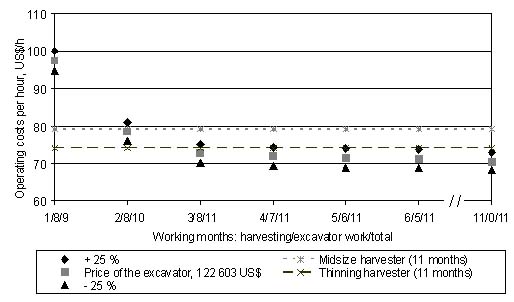
With 1½-shift work arrangements, the 25 % increase of purchase price only increased the operational hourly costs of harvesting by 3.4 % (2.5 US$). Therefore, the 25 % more expensive excavator with a purchase price of 153 253 US$ undercuts the operational hourly cost level of thinning harvesters after four months of harvester work.
The results of the changes of the harvester equipment's purchase price are reflected in the operating costs, when the price of the excavator remains at the initial value (Figure 4). The ± 25 % price change applicable to the initial harvesting equipment price is more sensitive on the operational costs than the price changes of the excavator, when harvesting is carried out for only one or two months. At a feasible level of harvesting work time (3 months), the operational hourly costs are competitive compared to the thinning harvester's costs, even if the cost of harvesting equipment is 25 % higher than the initial value.
Figure 4. The effects of harvesting equipment's price and harvesting month changes to operating costs per hour of the excavator-based harvester. 1½-work shift arrangement was used in the calculations.
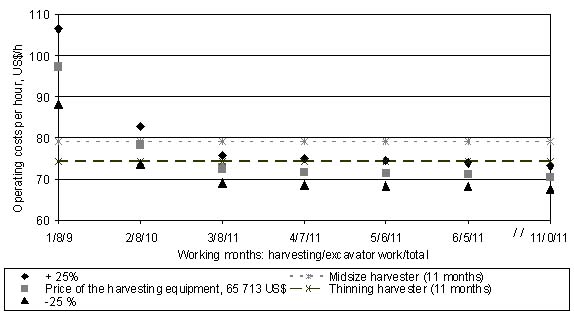
The unit costs of cutting were formulated for the excavator-based harvester with the aid of Niemi et al's [3] productivity values. Unit costs were calculated with 1 and 2 - shift work arrangements, when cutting was made for 4 months and excavation for 7 months. The unit costs of excavator-based harvester were compared to those of thinning harvesters. unit costs based on productivity and cost studies of thinning harvesters with the purchase price level presented in this paper [12, 15].
With the expressed work shift arrangements, unit costs are 9.7% higher, when operating in one shift instead of two shifts. In this comparison the excavator-based harvester seems to be cost-competitive and a feasible solution in all stem sizes showed in Figure 5.
Figure 5. The unit costs of cutting for excavator-based harvester and thinning harvesters (values from the studies of Ryynänen and Rönkkö [13]* and Siren and Aaltio [16]**).
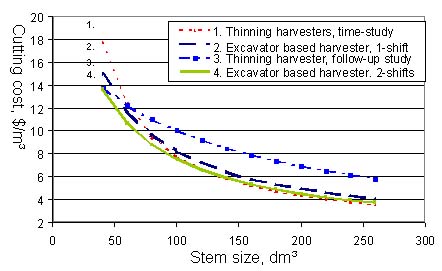
DISCUSSION
The operating hourly cost of the machine is a suitable factor for analysing cost fluctuation of a certain machine in a changing working environment and for finding economically feasible work concepts for the studied machine system. For comparing the cost competitiveness of different machines, the unit costs should be used. In this study both methods were used in the cost analysis. The excavator-based harvester's cost-competitiveness comparison with the unit costs was made to the thinning harvesters, which could potentially be used for peatland thinnings but are also capable for use in clear cuttings. In this case the unit cost comparison of machine works gives only trend setting results and the generalisation value is very low.
The productivity function of the excavator-based harvester [10] was formulated from the work performance of only one operator in peatland thinnings during the wintertime. The machine operator greatly affects the output of the harvester. In recent work studies of single grip harvesters the difference between experienced harvester operators' work output has been as much as 40 % or more [6, 13, 15, 18].
The operating costs of harvesting during the maximum number of working months (11 months) were also included in the cost calculation figures. It revealed that hourly operating costs were only slightly reduced when harvesting was increased to the maximum number of working months. In Finland, for excavator-based harvesters to be operational all year, additional harvesting on mineral soils will be required.
In addition to normal excavator work, 2-4 harvesting months were needed to keep the excavator-based harvester's costs at an economically feasible level, since it is dependent on the work shift arrangements. As a result of increased base machine utilization, operating hourly costs for the excavator work also diminishes. Additionally, ± 25 % changes to the initial purchase prices of the excavator or harvester equipment did not significantly affect the operating hourly costs, if harvesting was done for at least 4 months. The main reason for having feasible operating costs for the excavator-based harvester was the lower purchase price compared to purpose built harvesters and therefore even with lower productivity the unit costs of harvesting are still cost-competitive.
Cost calculations verify the assumption that it would be feasible and profitable to invest in harvesting equipment for the excavator which would reduce the winter lay-days of the base machine by utilizing it in logging operations. However, harvesting and especially thinning with a single grip harvester is demanding work with several aspects simultaneously influencing the decision making during operation. Attainment of an adequate performance level in thinnings, education and practical experience is needed over some years, regarding to work productivity and quality [2].
The expressed concept is an option for wintertime stressed harvesting on peatlands, where the base machine can provide work opportunities all year round. It also provides possibilities to reduce logistical costs by combining forestry projects on peatland forests, where both thinning and re-ditching are made by the same base machine, thereby reducing operational and translocation costs.
AUTHOR CONTACT
Kari Väätäinen can be reached by e-mail at -
Kari.Vaatainen@metla.fi
REFERENCES
[1] Anon. 2001. Finnish Statistical Yearbook of Forestry. Finnish Forest Research Institute. 374 pp.
[2] Gellerstedt, S. 2001. Operation of the Single-Grip Harvester: Motor-Sensory and Cognitive Work. International Journal of Forest Engineering. 13(2): 35-47.
[3] Gullberg, T. 2000. Excursions during the concerted action meeting. In: Johansson, J. [Ed.]. Excavators and backhoe loaders as base machines in forest operations: Proceedings from the second meeting of a concerted action FAIR-CT98-3381. Swedish University of Agricultural Sciences, Dept. of Forest Management and Products, Research Note 5. pp. 171-175.
[4] Hudson, R. J., J. B. Hudson and C. Saunders. 1999. Reliability and harvesting productivity when using excavators and backhoe loaders as base machines in forest operations. In: Johansson, J. [Ed.]. Excavators and backhoe loaders as base machines in forest operations: Proceedings from the first meeting of a Concerted Action FAIR-CT98-3381. Swedish University of Agricultural Sciences, Dept. of Forest Management and Products. Research Note 1. pp. 91-108.
[5] Johansson, J. 2000. Excavators and Backhoe Loaders as Base Machines in Logging Operations. Swedish University of Agricultural Sciences, Acta Universitatis Agriculturae Sueciae, Silvestria 141. 32 pp.
[6] Kariniemi, A. 2003. Metsäkonetyön kuva - ajattelun ja suunnittelun merkitys. [A view of forest machine work - The importance of thinking and planning]. In: Kehittyvä puuhuolto 2003 - Seminar Publication. pp. 13-22. (in Finnish).
[7] Lapiolahti, R. 2003. Personal communication. Kesko Oyj Konekesko. Construction Machinery. 3 September 2003.
[8] Lyons, J. 1999. Current use of excavators in Irish forestry. In: Johansson, J. [Ed.]. Excavators and backhoe loaders as base machines in forest operations: Proceedings from the first meeting of a Concerted Action FAIR-CT98-3381. Swedish University of Agricultural Sciences, Dept. of Forest Management and Products. Research Note 1. pp. 9-16.
[9] Mulari, J., R. Haarlaa, X. Sun and J. Wang. 1996. Mobility and feasibility of tracked excavators in forestry operations. University of Helsinki, Department of Forest Resource Management. Publications 11. 109 pp.
[10] Niemi, S., L. Finér, H. Laukkanen, M. Nousiainen, L. Sikanen and K. Väätäinen [Eds.] 2002. Suometsät - Tulevaisuuden tukkipuustot. [Peatland forests - the future forests of sawn timber]. Finnish Forest Research Institute. Research Notes 830. 73 pp. (in Finnish).
[11] Nuutinen, T. 2000. Suometsät osana metsätalouden kestävyyttä. [Peatland forests as a part of sustainable forestry]. Metsätieteen aikakauskirja 2/2000: 282-285. (in Finnish).
[12] Penttilä, T., H. Hökkä and R. Laiho. 2000. Harvennusten ekologiset perusteet ja tuottovaikutukset ojitetuilla rämeillä. [Ecological basics and yield effects of thinnings at ditched pine swamps]. Metsätieteen aikakauskirja 2/2000: 292-296. (in Finnish).
[13] Ryynänen, S. and E. Rönkkö. 2001. Harvennusharvestereiden tuottavuus ja kustannukset. [Productivity and expences associated with thinning harvesters]. TTS -Institute. Publications 381. 67 pp. (in Finnish).
[14] Salo, T. and J. Uusitalo. 2001. Ensiharvennusmännyn tehdashinnan kustannusrakenne. [The cost structure of mill delivered pine bolts]. University of Joensuu. Faculty of Forestry. Research Notes 127. 53 pp. (in Finnish).
[15] Sirén, M. 1998. Hakkuukonetyö, sen korjuujälki ja puustovaurioiden ennustaminen. [One-grip harvester operation, its silvicultural result and possibilities to predict tree damage]. Finnish Forest Research Institute. Research Notes 694. 179 pp. (in Finnish)
[16] Sirén, M. and H. Aaltio. 2001. Seurantatutkimus. In: Kärhä, K. [Ed.]. Harvennuspuun koneelliset korjuuvaihtoehdot. [Alternative Harvesting Systems in Mechanised Thinning]. Final Report of HARKO Project (1999-2001). TTS -Institute. Publications 382. 93 pp. (in Finnish).
[17] Spinelli, R. and R. Spinelli. 2000. The use of excavators in forestry and in digging: working cycles compared. In: Johansson, J. [Ed.]. Excavators and backhoe loaders as base machines in forest operations: Proceedings from the second meeting of a concerted action FAIR-CT98-3381. Swedish University of Agricultural Sciences, Dept. of Forest Management and Products, Research Note 5. pp. 117-121.
[18] Väätäinen, K., H. Ovaskainen, A. Asikainen and L. Sikanen, 2003. Chasing the tacit knowledge - automated data collection to find the characteristics of a skillful harvester operator. 2nd Forest Engineering Conference. 12-15 May, Växjö, Sweden. Proceedings. Arbetsrapport. Skogforsk. Nr. 539. pp. 3-10.
